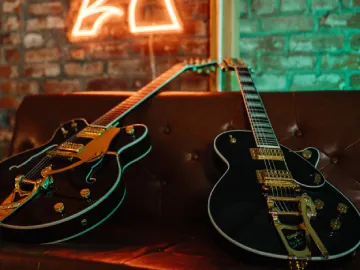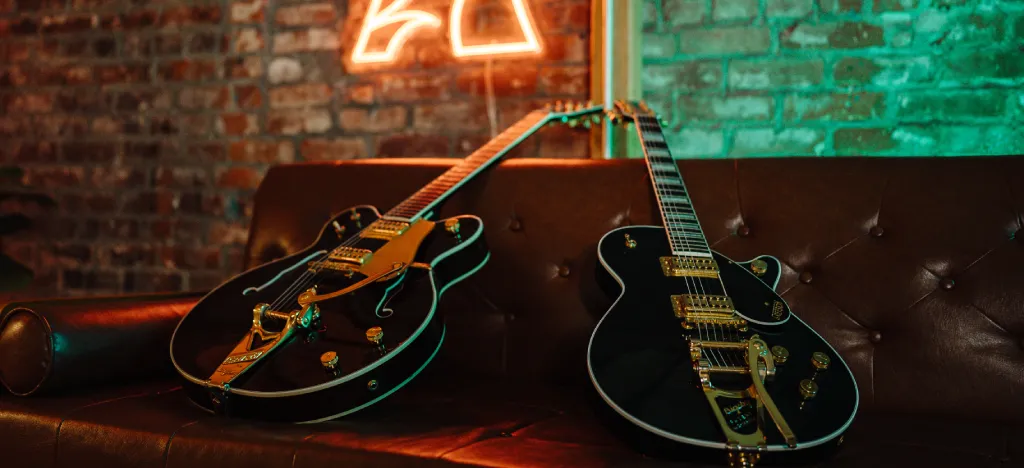My first guitar was an acoustic — a surprise gift in my teens. I had no idea how to play, but that didn’t stop me. Before long, I’d bought my first electric guitar and joined a band. However your journey unfolds, choosing the right guitar is a big first step.
This guide will walk you through the essentials: the differences between acoustic and electric guitars, what to look for in your first instrument, whether to buy new or used, and a free video to help you understand guitar anatomy.
- Should you start with acoustic or electric?
- What is an acoustic guitar? Pros, tone, and beginner benefits
- What is an electric guitar? Pickups, body styles, and who it’s for
- Free video guide: Exploring the guitar body
- Acoustic vs electric guitar: Beginner-friendly comparison guide
- How to choose your first guitar: 10 essential tips
- Things to look for when trying out a guitar
- Should you buy a new or used guitar?
- Recommended guitars for beginners
- Online guitar courses
- FAQs: Choosing your first guitar
Should you start with acoustic or electric?
The best choice is the one that inspires you to keep playing — but your musical goals can help guide you. If you want something simple, portable, and great for unplugged styles, an acoustic guitar is a solid starting point. If you're excited by rock, pop, or want to play with effects and amps, an electric guitar might feel more fun (and a bit easier on the fingers).
You don’t need to overthink it — both types are great for beginners. But before you decide, here’s what to know about each.
What is an acoustic guitar? Pros, tone, and beginner benefits
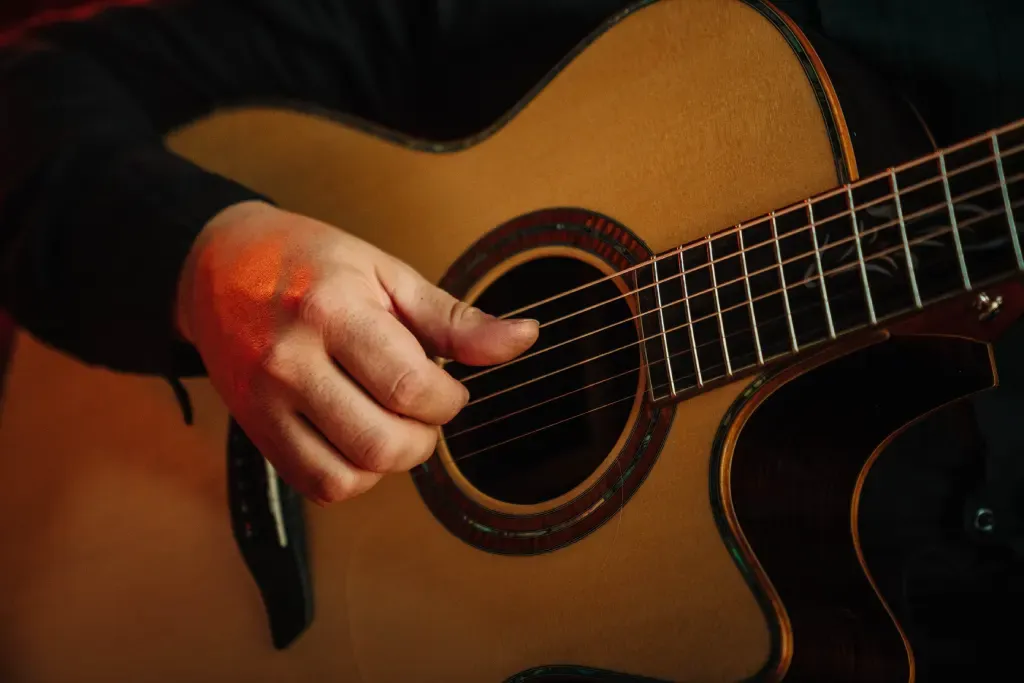 Acoustic guitars are a great choice if you want something simple, portable, and ready to play without an amp. They’re perfect for singer-songwriter styles, folk, classical, and even some pop.
Acoustic guitars are a great choice if you want something simple, portable, and ready to play without an amp. They’re perfect for singer-songwriter styles, folk, classical, and even some pop.
The sound comes from the vibration of the strings over a hollow wooden body — no electronics required. Wood type and string type both shape the tone, giving you options from warm and mellow to bright and crisp.
Key differences:
Classical vs. Steel-String
Classical guitars use nylon strings that are softer on the fingers and produce a mellow, rounded tone — ideal for beginners or fingerstyle playing.
Steel-string guitars are louder, brighter, and common in folk, rock, and modern acoustic music.Wood Types
Spruce gives a bright, responsive tone
Cedar adds warmth and softness
Maple, rosewood, and mahogany each bring their own flavour — from deep and earthy to sharp and articulate
💡ARTMASTER TIP: If you’re interested in learning acoustic guitar, check out ArtMaster’s Acoustic Guitar for Beginners course with LA-based teacher Orbel Babayan, guitarist for Scars on Broadway
What is an electric guitar? Pickups, body styles, and who it’s for
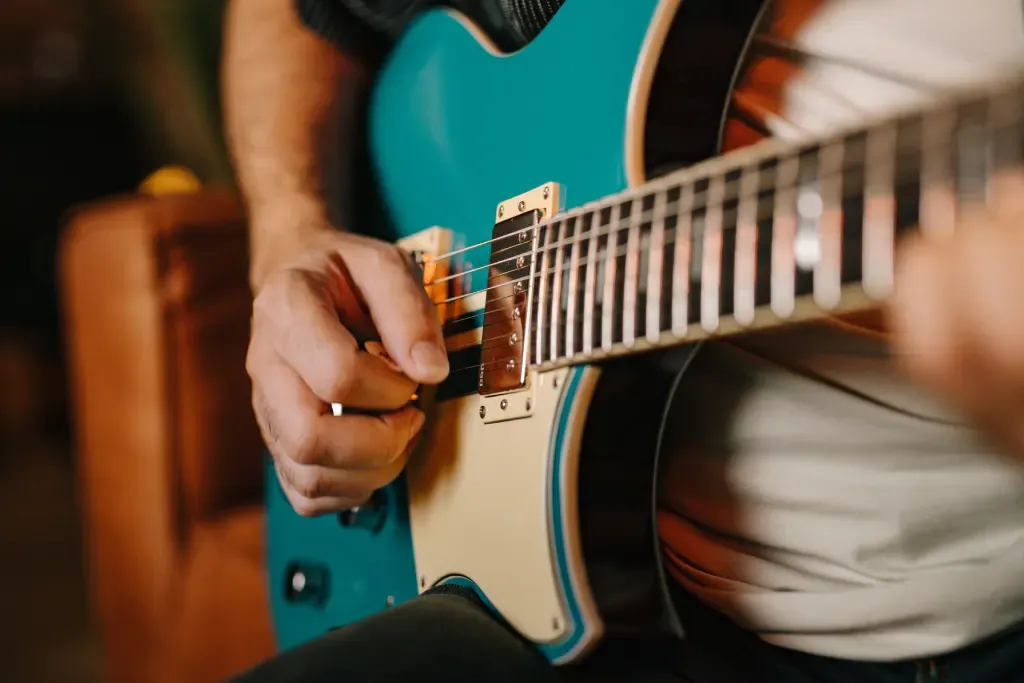 Electric guitars are ideal if you’re into rock, blues, metal, or pop — or just want more tonal variety and playability. They need an amp to be heard properly, but that’s where their real strength lies: you can shape your sound endlessly with effects and tone controls.
Electric guitars are ideal if you’re into rock, blues, metal, or pop — or just want more tonal variety and playability. They need an amp to be heard properly, but that’s where their real strength lies: you can shape your sound endlessly with effects and tone controls.
Unlike acoustics, electric guitars have a solid body with no sound chamber. Their sound is created by pickups — electronic components that capture string vibrations and send them to your amp.
Key differences:
Pickups
Single-coil pickups give a bright, crisp tone (great for funk, indie, and clean sounds)
P90s sit between single coils and humbuckers — warm but with some edge
Humbuckers produce a thicker, more powerful sound — ideal for rock, metal, and jazz
Body Styles
Stratocaster-style guitars are lightweight and versatile with a contoured body
Les Paul-style guitars are heavier, with a rich, sustain-heavy tone
Each has its own feel — try both if you can to see what fits you best.
💡ARTMASTER TIP:: If you’re more interested in learning electric guitar, check out ArtMaster’s Electric Guitar for Beginners course with Dre DiMura, guitar sensation with over 70M TikTok views. There's a free video from his course below!
Free video guide: Exploring the guitar body
Check out creator Dre DiMura's free video guide to the different components that make up the body of an electric guitar — the bridge, pickups, tone and volume controls, and the pickup selector switch.
If that has given you inspiration to learn electric, have a look at his full Electric Guitar for Beginners course. Try it for free as part of your 7-day free trial.
Acoustic vs electric guitar: Beginner-friendly comparison guide
As you can see, choosing between an acoustic and an electric guitar isn’t about right or wrong — it depends on what kind of player you want to be. Acoustic guitars are simple, portable, and perfect for learning without extra gear. Electric guitars are easier on the fingers and offer a wider range of tones, but they do require an amp and accessories.
Acoustic Guitar | Electric Guitar | |
Budget | $100 - $500 | $200 - $600 (+ amp and accessories) |
Musical Style | Folk, Country, Singer-Songwriter | Rock, Metal, Blues, Jazz |
Playability | Softer strings, wider fretboards | Lighter strings, slimmer necks |
Sound | Warm, resonant, natural | Versatile, modified with amp settings |
Size and Shape | Dreadnought, Concert, Auditorium | Stratocaster, Les Paul, SG, Telecaster |
Learning Genre | Great for learning chords and strumming | Ideal for solos and experimenting with effects |
Maintenance | Less maintenance required | More maintenance due to electronic components |
Additional Gear | Not necessary, but a tuner and case are useful | Requires amplifier, cables, possibly pedals |
Portability | Highly portable | Less portable due to additional gear |
Volume Control | Through playing technique | Volume easily controlled via amp |
How to choose your first guitar: 10 essential tips
Decide on acoustic or electric
Acoustic guitars are simple, portable, and great for folk or singer-songwriter styles. Electric guitars suit rock, pop, and blues — and are often easier to press down.Set your budget
Most beginners find a good-quality guitar in the $100–$300 range. Factor in extras like a case, tuner, or amp if you go electric.Try before you buy
Head to a music shop and try a few guitars. Focus on how each one feels — don’t be swayed by brand names alone.Check playability
Look for low action (string height), a neck that fits your hand comfortably, and good tuning stability. A well-set-up guitar is easier to learn on.Pick the right size and shape
For acoustics, body size affects tone and comfort. For electrics, body style impacts feel and weight. Choose what suits you.Understand wood and pickups
Acoustic tonewoods (like spruce or mahogany) affect warmth and brightness. Electric pickups (single coil, P90, humbucker) shape your sound.Think long term
If you plan to stick with guitar, consider something you won’t outgrow too quickly — a guitar that can grow with you.Do your research
Watch reviews, read beginner guides, and check what guitars your favourite artists use — it can help clarify your goals.Don’t rush it
Take your time. A rushed purchase often leads to regret (and an unused guitar in the corner).Go with what inspires you
Ultimately, the best beginner guitar is the one that excites you. If it makes you want to keep playing, it’s the right one.
💡ARTMASTER TIP:: When learning guitar, there are some essential tools you’ll need. We've put together a collection of free customizable guitar tools, where you’ll find a chord chart generator, a metronome, and a guitar tuner. And be sure to check out our guides on reading chord charts, how to properly tune a guitar and practising with a metronome.
Things to look for when trying out a guitar
Can I reach all parts of the fretboard easily? Is the entire fretboard within my comfortable reach, and do the fret ends feel smooth against my hand?
How far are the strings from the fretboard? Strings should be at a comfortable distance from the fretboard. Excessively high action at the neck-body joint suggests potential problems.
Does the guitar stay in tune? After tuning and playing a few chords, does the guitar keep its tuning, or does it go out of tune?
Is the neck of the guitar straight? Looking down the length of the guitar's neck, do I notice any bending or warping?
For electric guitars, are the electronics in good working order? When plugged into an amplifier, do turning the knobs and flipping the switches produce any unwanted noise or crackling?
Should you buy a new or used guitar?
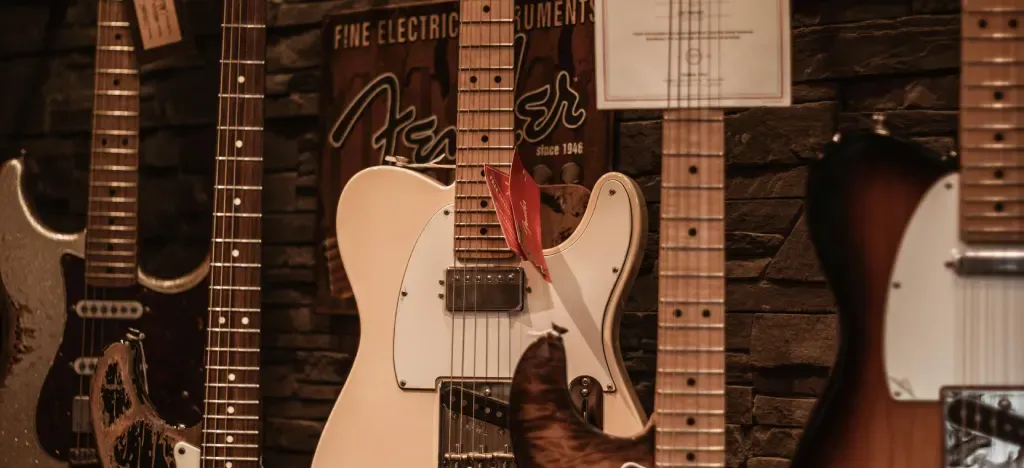 My first electric was new, bundled in with a cheap amp and case, but my second one was used, from a little music shop. Both have their pros and cons:
My first electric was new, bundled in with a cheap amp and case, but my second one was used, from a little music shop. Both have their pros and cons:
Advantages of buying a new guitar
Latest features: Often come equipped with the latest innovations in guitar design, offering enhanced playability and sound.
Pristine condition: There's a unique appeal in the flawless appearance and untouched feel of a brand-new instrument.
Warranty and support: Buying new usually includes a manufacturer warranty and the option for dealer support in case of issues.
Advantages of buying a used guitar
Affordability: Used instruments are often more budget-friendly, allowing access to higher-quality guitars for less money.
Keeps its value: A used guitar has already undergone most of its depreciation, so it can retain its value better over time.
Character and tone: Older guitars can offer a vintage charm and a matured sound that many musicians seek, which new guitars might not yet possess.
Recommended guitars for beginners
Once you’ve got a sense of what type of guitar fits you best, here are some beginner-friendly models that are known for their comfort, quality, and price.
Acoustic Guitars
Yamaha FG800: Outstanding build quality, versatile, affordable
Fender CD-60S: Spruce top, warm tone, easy playability, accessory bundle option
Taylor GS Mini: Compact, excellent sound, higher price
Electric Guitars
Squier Affinity Stratocaster: Classic shape, good sound, budget-friendly
Epiphone Les Paul Special-II: Iconic design, versatile sound, comfortable neck
Yamaha Pacifica PAC112V: High quality, solid alder body, versatile
Classical Guitars
Cordoba C5: Traditional Spanish craftsmanship, warm sound.
Yamaha C40II: Budget-friendly, clear and balanced tone, easy play.
There's no one-size-fits-all answer when choosing your first guitar. Consider what music inspires you, your budget, and how you plan to practice and perform. Whether you start with an acoustic's natural warmth or an electric's versatile sound, the right guitar will keep you motivated on your musical journey.
💡 ARTMASTER TIP: Just picked your first guitar? Start strong with songs that are easy to play and sound great right away. These beginner-friendly favourites use just two, three, or four chords — perfect for building confidence, rhythm, and fun.
Also check out our guide to essential guitar techniques every player should know — for sounding smoother, faster, and more expressive as you grow.
Online guitar courses
We have video courses taught by some of the leading guitarists: Arianna Powell (Dua Lipa), Dre DiMura (70M TikTok views), Orbel Babayan (Scars on Broadway), and Kfir Ochaion (soloist with 5M followers).
Don't miss this chance to learn from the best!
Try Our FREE 7-Day Trial!

FAQs: Choosing your first guitar
What type of guitar is best for beginners?
Both acoustic and electric guitars are great for beginners — it depends on your goals. Acoustic guitars are simple and portable, while electric guitars are easier to press down and allow you to experiment with different tones.
Should I start with an acoustic or electric guitar?
If you want to play unplugged, folk, or singer-songwriter music, start with an acoustic. If you're more into rock, pop, or metal, an electric guitar might be more motivating. There's no wrong answer — just pick the one that inspires you most.
How much should I spend on my first guitar?
Most beginners find a great starting guitar in the $100–$300 range. You don’t need the most expensive model — just something comfortable, playable, and reliable. Entry-level models from well-known brands are usually safe bets.
Is it better to buy a new or used guitar?
New guitars offer peace of mind and warranties, while used guitars can be more affordable. If buying used, make sure the guitar is playable, with no major damage, and consider bringing a more experienced player with you to check it.
Do I need an amp if I buy an electric guitar?
Yes — but for home practice, even a small, affordable amp or a headphone amp will do. Some digital apps or interfaces also let you play through your phone or computer with great results.
What size guitar should I get?
Adults usually play full-size guitars (sometimes called 4/4). Younger players or people with smaller hands might find ¾ size or short-scale guitars more comfortable.
About the author
Matt Ford is a musician, teacher, writer, and lifelong student of sound.
With years of experience in both performing and teaching, he shares practical advice through ArtMaster to help musicians at every level build skill and confidence in their playing.
